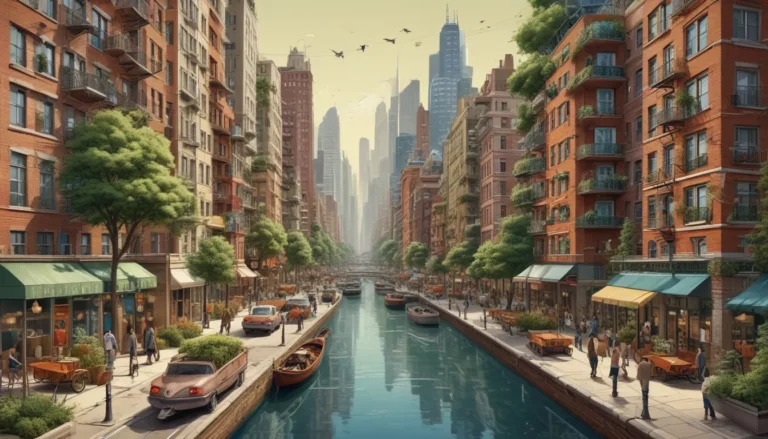A Note About Images: The images used in our articles are for illustration purposes only and may not exactly match the content. They are meant to engage readers, but the text should be relied upon for accurate information.
Green belts are more than just expanses of open land surrounding urban areas; they are vital spaces that contribute to the well-being of both the environment and the communities they serve. As designated areas that prevent urban sprawl, promote conservation, and enhance biodiversity, green belts offer a wide range of benefits that extend far beyond their lush vegetation. In this article, we will delve into 19 captivating facts about green belts that underscore their significance and impact on our world. Whether you have a passion for nature, a keen interest in sustainability, or are simply curious about the wonders of our planet, join us in discovering the remarkable role that green belts play in shaping our urban environments.
Key Takeaways:
- Green belts are designated open areas around cities, preventing urban sprawl and providing recreational opportunities while supporting biodiversity and improving air quality.
- They act as a barrier between urban and rural areas, controlling urban development, reducing flooding risks, and promoting physical and mental well-being.
Green Belts: Preserving Nature and Promoting Sustainable Development
Green belts serve as designated areas of open land surrounding urban centers, playing a crucial role in preserving nature and promoting sustainable development. These unique spaces act as a barrier between urban and rural landscapes, preventing urban encroachment into agricultural and natural areas while maintaining the distinct character of each region. By restricting development within their boundaries, green belts help control urban sprawl and protect the environment from excessive exploitation. In addition to their conservation efforts, green belts also provide recreational opportunities, support biodiversity, and enhance the overall aesthetics of cities.
The Environmental Benefits of Green Belts
1. Promoting Conservation and Biodiversity
Green belts offer habitats for a diverse range of plant and animal species, contributing to the preservation of biodiversity and ecological balance. By providing undisturbed areas for wildlife to thrive, green belts play a crucial role in supporting the delicate ecosystems that exist within and around urban centers. These designated open spaces act as wildlife corridors, allowing for the movement of species and promoting genetic diversity among populations. Additionally, green belts help conserve cultural heritage by encompassing historically significant sites and cultural landscapes, ensuring the protection and celebration of a region’s heritage.
2. Improving Air Quality and Reducing Pollution
One of the most significant environmental benefits of green belts is their ability to improve air quality by absorbing and filtering pollutants. By acting as natural air purifiers, green belts help reduce the impacts of urban pollution on surrounding areas, creating a healthier living environment for residents. In addition to their role in mitigating air pollution, green belts can also aid in noise reduction by acting as natural sound barriers, helping to minimize noise pollution from highways, industrial areas, and other sources.
3. Mitigating Climate Change
Green belts play a vital role in climate change mitigation by absorbing carbon dioxide from the atmosphere and reducing greenhouse gas emissions. By sequestering carbon and promoting green infrastructure, green belts contribute to creating a more sustainable and resilient urban environment. In addition to reducing carbon emissions, green belts also help control flooding risks by acting as natural floodplains, absorbing excess rainfall and reducing the likelihood of flooding in urban areas.
The Social Benefits of Green Belts
1. Enhancing Physical and Mental Well-being
Access to green spaces has been shown to have positive effects on both physical health and mental well-being. By providing opportunities for exercise, relaxation, and stress reduction, green belts promote overall well-being and quality of life for residents. These open areas offer city dwellers a reprieve from the hustle and bustle of urban life, allowing them to connect with nature and reap the benefits of spending time outdoors.
2. Providing Recreational Opportunities
Green belts often contain parks, trails, and other recreational facilities, offering city residents access to nature and outdoor activities. Whether it’s a leisurely stroll through a scenic park or a challenging hike along a nature trail, green belts provide opportunities for recreational engagement and physical activity. These green spaces serve as valuable community resources, bringing people together and fostering a sense of connection to the natural world.
3. Supporting Sustainable Agriculture
Within green belt areas, there is often a focus on sustainable agricultural practices and the preservation of farmland. By promoting sustainable farming methods and preserving agricultural land, green belts contribute to long-term food security and agricultural sustainability. These designated areas play a vital role in supporting local farmers and ensuring the availability of fresh, locally grown produce for urban communities.
The Economic Benefits of Green Belts
1. Boosting Property Values
Living near a green belt can increase property values, as it offers residents access to open spaces, nature, and recreational opportunities. Properties located in close proximity to green belts are often in high demand due to their scenic views, environmental amenities, and quality of life benefits. As a result, property values in these areas tend to appreciate over time, providing homeowners with a tangible economic benefit.
2. Contributing to Sustainable Urban Planning
Green belts are an integral part of sustainable urban planning, ensuring a balance between development and the preservation of natural areas. By incorporating green belts into urban design and land use planning, cities can create healthier, more livable environments for their residents. These designated open spaces contribute to the overall sustainability of urban areas, promoting environmental protection, social equity, and economic vitality.
3. Providing Educational and Research Opportunities
Green belts offer valuable opportunities for environmental education, research, and conservation initiatives. These open areas serve as living laboratories where researchers, students, and community members can learn about the natural world, conduct scientific studies, and engage in conservation efforts. By providing a platform for environmental education and research, green belts help raise awareness about the importance of conservation and sustainability among the public.
Conclusion
In conclusion, green belts play a vital role in shaping our urban environments and promoting a harmonious balance between development and conservation. From preserving biodiversity and improving air quality to enhancing physical and mental well-being, these designated open spaces offer a myriad of benefits that enrich the lives of residents and contribute to the overall sustainability of our cities. As we continue to protect and expand green belts around the world, we are paving the way for a greener, healthier, and more resilient future for generations to come.
Explore the wonders of green belts, and discover the beauty and benefits of these unique areas that bridge the gap between urbanization and the natural world. Join us in celebrating the remarkable role that green belts play in creating sustainable and livable cities for all.
Frequently Asked Questions
Q: What exactly is a green belt?
A: A green belt is a designated area of land surrounding urban centers that is protected and preserved to limit urban sprawl, maintain open space, and promote environmental sustainability.
Q: What are the benefits of green belts?
A: Green belts provide numerous benefits, including improving air and water quality, preserving biodiversity, promoting physical and mental well-being, offering recreational spaces, and contributing to the overall aesthetic appeal of cities.
Q: Can green belts help combat climate change?
A: Yes, green belts play a crucial role in mitigating the effects of climate change. They help absorb carbon dioxide, reduce the heat island effect, control flooding, and provide wildlife habitats, all of which contribute to creating a more sustainable and resilient urban environment.
Q: Are there any downsides to green belts?
A: While green belts provide numerous benefits, there can be some challenges associated with their implementation, such as higher land prices, limited availability of land for development, and potential conflicts between preservation and urban expansion. However, with careful planning and management, these issues can be mitigated.
Join us in celebrating the remarkable wonders of green belts and discover the beauty and benefits of these unique areas that bridge the gap between urbanization and the natural world. By exploring the vital role that green belts play in shaping our urban environments, we can gain a deeper appreciation for the importance of conservation, sustainability, and well-being in creating vibrant and resilient cities for all.






